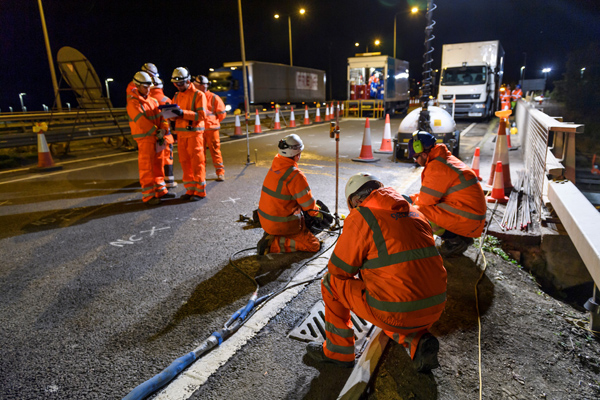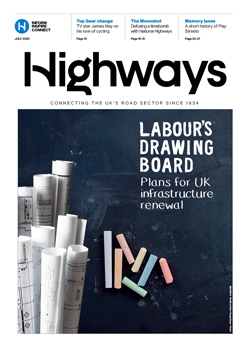Richard Holmes (pictured), MD of specialist civil engineering contractor Geobear, has big plans for the company, hoping to double its size in the next five years. He speaks to Dominic Browne about why his team should be in the spotlight.

What is the big news from Geobear at the moment?
We have recently completed two carbon studies that compare traditional techniques of subsidence repair with ours. For the recent studies, we compared our work on the railways and a domestic property. For the railway study, we were working on a level crossing, which needed to be re-levelled because it was suffering severe subsidence.
Our technique is a geopolymer injection. For the railway work, it involved drilling a 14mm diameter hole through the concrete slabs that form the level crossing.
We drill them on an approximately one-metre spaced grid pattern and we then insert a 12mm diameter steel tube to just the underside of the slab. This is attached to our injection gun, which connects to the pumps on our injection unit. We start injecting the expansive geopolymer underneath the slab. That raises the slab and re-levels it and it also strengthens the sub-grade material below the slab.
Without doing that the ride quality for the train becomes unacceptable. The train is getting too much deflection on the rails and this particular level crossing had a class 2 track fault, which means it would have to close because it was unsafe to operate. Conventional works would have meant ripping up the whole level crossing and re-laying it with reinforced concrete steel rails. The findings of our study showed there was a 37% reduction in the carbon emissions using our technique, and on the residential property, there was about a 30% reduction.
Where has it been used on the roads and what results have you produced?
Our technique has been used extensively on the national and local road network - on the M25, the M11 the A41 the A404, the M42. We have also used it in Buckinghamshire, Hertfordshire, Essex and North Yorkshire. We are a specialist sub-contractor and usually employed by Tier One or Tier Two companies. Occasionally we’re employed directly by clients like National Highways.
For instance, we might use it on motorways that have joints every 20 metres or so with black mastic seals. If those seals get broken it allows water to get into the joint and percolate under the slabs and start washing out material.
Every time a lorry goes over slab you get vibration and the water starts pumping and pumping more material out from under the slab. Eventually, the slab starts rocking and if it is not treated and stabilised it will break.
It is common on roads, airports, taxiways and runways. It can happen virtually anywhere.
The durability of our materials is in excess of 120 years, so it is a very durable material. We have done studies that show by using it to stabilise road slabs we can extend the life of the asset by nine years. In a rail environment, we can extend the life by six years. That is still very cost-effective and much quicker than the alternative. The alternative in a road would be a replacement every 40 years, and on a rail level crossing a replacement every 60 years but the carbon from our repair treatments is still less than the one total replacement every 40 or 60 years. So we are still very carbon efficient.
It can also be applied for utilities where a sewer might have burst in a road, causing massive subsidence. We would install our material around that area to consolidate the ground to enable safe excavation for the replacement of the sewer.

What are your unique selling points for these repairs?
The technique comes into its own where the asset has to keep running. For instance, in a motorway environment where it is difficult to close the motorway. We ensure a lack of disruption to the end user. If you are employing traditional, conventional techniques of repairs the disruption to the travelling public is huge. If you are using our solutions, we are quickly in and out of the site. We can demobilise very quickly at the end of a nighttime possession and the road can be up and running again. There is no curing time on these materials. They are not like cement, which has to cure for 24 hours or more. That is the biggest thing; the lack of disruption to the network.
What changes would you like to see brought into the highways sector?
Running a highways network in the UK is a major challenge for anybody. We have an awful lot of vehicles on the road.
I would like to see asset owners embracing innovation a little bit more than they do. I would like to see them pushing innovation. It tends to be a little too slow on the uptake.
They should look at the whole-life cost. Sweating the asset if you like. Repair rather than replace the asset and carry out that preventative maintenance using techniques like ours or those of others.
What is your future ambition for Geobear?
My ambition is to see Geobear challenging as one of the major geotechnical contractors in the country and growing to become the client’s first choice when they have a ground engineering problem.
I think that is more than doable. It would probably mean doubling the staff size and we should be able to do that level of work. Currently, in the UK, we have around 75 staff with 15 specialist injection units.
Tell us, something about yourself not many people know.
I am a mad keen karaoke fan.
Signature tune?
I have a whole list but probably ‘Bat Out of Hell’.
Gone before the morning comes. We get it.
You can register here for a Geobear webinar on Geopolymers and asset life extension for highways.





